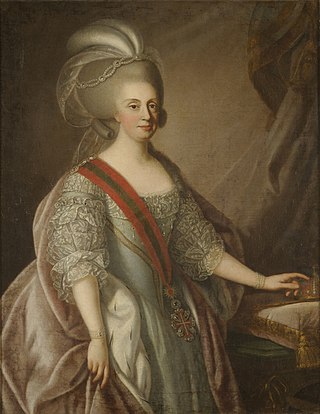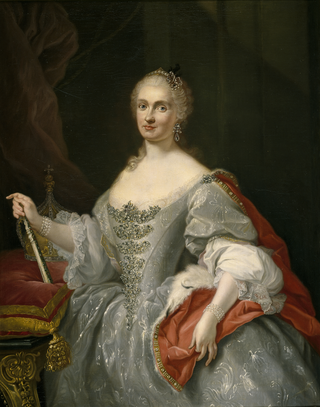Related Research Articles

Conrad, a member of the Hohenstaufen dynasty, was the only son of Emperor Frederick II from his second marriage with Queen Isabella II of Jerusalem. He inherited the title of King of Jerusalem upon the death of his mother in childbed. Appointed Duke of Swabia in 1235, his father had him elected King of Germany and crowned King of Italy in 1237. After the emperor was deposed and died in 1250, he ruled as King of Sicily until his death.

DonaMaria I was Queen of Portugal from 24 February 1777 until her death in 1816. Known as Maria the Pious in Portugal and Maria the Mad in Brazil, she was the first undisputed queen regnant of Portugal and the first monarch of Brazil.

Nzinga Ana de Sousa Mbande, Nzhinga was a southwest African ruler who ruled as queen of the Ambundu Kingdoms of Ndongo (1624–1663) and Matamba (1631–1663), located in present-day northern Angola. Born into the ruling family of Ndongo, her grandfather Ngola Kilombo Kia Kasenda was the king of Ndongo.

A queen regnant is a female monarch, equivalent in rank, title and position to a king. She reigns suo jure over a realm known as a kingdom; as opposed to a queen consort, who is married to a reigning king; or a queen regent, who is the guardian of a child monarch and rules pro tempore in the child's stead or instead of her husband who is absent from the realm, be it de jure in sharing power or de facto in ruling alone. A queen regnant is sometimes called a woman king. A princess regnant is a female monarch who reigns suo jure over a principality; an empress regnant is a female monarch who reigns suo jure over an empire.
The Kingdom of Ndongo, 1515-1671, was an early-modern African state located in the highlands between the Lukala and Kwanza Rivers, in what is now Angola.
The Kingdom of Matamba (1631–1744) was an African state located in what is now the Baixa de Cassange region of Malanje Province of modern-day Angola. Joined to the Kingdom of Ndongo by Queen Nzinga in 1631, the state had many male and female rulers. It was a powerful kingdom that long resisted Portuguese colonisation attempts, but was integrated into Portuguese Angola in the late nineteenth century.

Maria Amalia was Queen of Spain from 10 August 1759 until her death in 1760 as the wife of King Charles III. Previously, she had been Queen of Naples and Sicily since marrying Charles on 19 June 1738. She was born a princess of Poland and Saxony, daughter of King Augustus III of Poland and Princess Maria Josepha of Austria. Maria Amalia and Charles had thirteen children, of whom seven survived into adulthood. A popular consort, Maria Amalia oversaw the construction of the Caserta Palace outside Naples as well as various other projects, and she is known for her influence upon the affairs of state.
Verónica Guterres Kangala Kingwanda was the ruler of the joint kingdom of Ndongo and Matamba, 1681–1721.

The Ambundu or Mbundu (Mbundu: Ambundu or Akwambundu, singular: Mumbundu are a Bantu people who live on a high plateau in present-day Angola just north of the Kwanza River. The Ambundu speak Kimbundu, and most also speak the official language of the country, Portuguese. They are the second biggest ethnic group in the country and make up 25% of the total population of Angola.
The precolonial history of Angola lasted until Portugal annexed the territory as a colony in 1655.
The Battle of Katole was a military engagement between forces of Portuguese Angola and the Kingdom of Matamba. The battle took place on 4 September 1681 at Katole in what is today Angola. It was one of the largest military engagements anywhere in the world during the 17th century.
The Portuguese colony of Angola was founded in 1575 with the arrival of Paulo Dias de Novais with a hundred families of colonists and four hundred soldiers. Luanda was granted the status of city in 1605. The fortified Portuguese towns of Luanda and Benguela.
Tehaʻapapa I was a Queen regnant of the island of Huahine. She was the ruler of that island during the time Captain Cook visited the island and an ancestor of Queen Teha'apapa II.
Mukambu Mbandi was the queen regnant of the Kingdom of Ndongo and Matamba from 1663 to 1666.
Ana II Guterres da Silva Ngola Kanini was the queen regnant of the Kingdom of Ndongo and Matamba from 1742 to 1756.
Verónica II Guterres was the queen regnant of the Kingdom of Ndongo and Matamba from 1756 to 1758.
Tribhuvana Mahadevi II also known as Prithivi Mahadevi, was the queen regnant of the Indian Bhauma-Kara dynasty's Kingdom of Toshala in Kalinga in 890-896 AD.
Kamana, Queen of Jinga was the queen regnant of the Kingdom of Jinga from 1767 to 1810.
Princess Kifunzi of Ndongo also known as Funji or Lady Grace, her sisters, Nzinga of Ndongo and Barbara of Matamba, were well revered and respected in Kabasa, the capital and the royal home, as well as the rest of Ndongo. Historically, Funji’s name can also be seen in documents as "Funje," "Kifunzi," and "Funzi," depending on the time period. Funji was known to be beautiful and often compared to her mother, Batayo.
References
- ↑ Anthony Appiah, Henry Louis Gates, Encyclopedia of Africa, Volym 1
- Anthony Appiah, Henry Louis Gates, Encyclopedia of Africa, Volym 1
- Fernando Campos: Conflitos na dinastia Guterres através da sua cronologia1, África: Revista do Centro de Estudos Africanos. USP, S. Paulo, 27-28: 23-43, 2006/2007